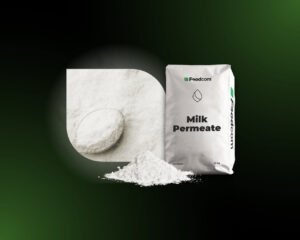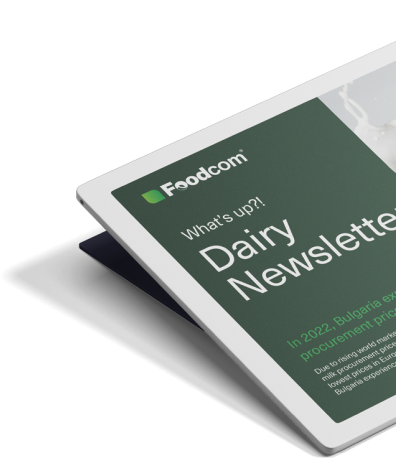- Global milk production is growing rapidly in all major regions thanks to favorable weather and lower feed costs.
- In the United States, production reached 70.1 million tons, an increase of 3.2% month-on-month and 1.1 million tons year-on-year.
- Analysts warn that further growth will depend on the stability of energy and feed prices.
- The New Zealand government is considering tightening regulations to limit Fonterra’s dominance and strengthen competition in the dairy sector.
Welcome Partners!
Welcome back to our newsletter!
The end of October brings a mixed mood on the global dairy markets. Milk production remains high in many countries, while at the same time demand, especially from industry and exports, shows no signs of clear recovery. Global Dairy Trade recorded a decline of 1.4% in the latest quotation, confirming continued price pressure. In New Zealand, milk procurement was up 2.5% year-on-year, and this means that more raw material will come to market in the coming weeks.
In Europe, the situation is similar. There is no shortage of milk and raw material prices on the spot market remain under pressure. Some farmers are choosing to retire older cows early, but for the time being this is not significantly affecting supply. The market seems saturated and processors are trying to strike a balance between maintaining production and minimising stocks. International trade is quiet as many countries have already completed contracting for this year.
Scroll down for detailed market data and forecasts.
Milk powder
The milk powder market remains under clear oversupply pressure. Skimmed milk powder prices have fallen in recent days to around €2,000/MT in both the food and feed segments. The high availability of raw material and low prices for milk concentrates mean that processors are unable to improve margins.
Whole milk powder is also cheapening, with average prices falling to levels below €3,600/MT. Producers are trying to maintain liquidity by diverting some raw material into more profitable categories. Exports from the European Union are limited, although demand from North Africa and the Middle East remains moderate. China, traditionally a key buyer of WMP, is importing slightly more than a year ago, but not enough to affect the global balance sheet.
A downward trend also prevails on world markets. In Oceania, whole milk powder prices have fallen below EUR 3 200/MT and in the US they remain just above EUR 2 100/MT for skimmed powder. The global market for milk powders therefore remains saturated and a possible recovery will only be possible with a reduction in milk production towards the end of the year.
Cheese
The cheese market in Europe has stabilised after several weeks of declines, but prices remain low. Gouda and mozzarella remain in the range of around €2,800/MT. Although demand from retail chains in Germany and Benelux is satisfactory, exports outside the European Union are still not back to previous levels.
Cheddar remains under pressure, with curd prices at around EUR 3,400/MT. Cagliata is also trading at around EUR 3200/MT, reflecting the generally subdued market sentiment. High production and limited export demand continue to limit any potential recovery. Processors are cautious and the market is waiting for a signal strong enough to improve sentiment. In Oceania, production is rising in line with seasonal trends, while in the US, domestic demand is helping to maintain a relative balance in the market.
Globally, the cheese segment is still saturated. Europe, as the largest producer, sets the price direction, and continued oversupply in the region limits growth potential.
Fats
The downward trend in the dairy fats market continues. Butter prices in Europe have slipped to just above €5,100/MT and are even lower in some countries such as France and Ireland. Despite good retail sales, especially in Germany, processors are still facing large stocks.
Cream prices, on the other hand, have risen above EUR 6,000/MT, which is mainly due to a temporary recovery in the short-term contract market. Industrial demand, however, remains moderate. In Oceania, butter prices are higher than in Europe, but supply pressures are starting to become apparent there too. In the United States, dairy fat quotations remain stable but at historically low levels, with the market waiting for a boost from seasonal demand over the Christmas period.
Liquids
The market for liquid dairy components is highly volatile. Skimmed milk concentrate prices remain in the range of around EUR 1 200/MT to EUR 1 400/MT, and cream has returned to levels above EUR 6 000/MT. Despite this, the overall availability of milk in Europe remains high.
In many regions, producers are reporting full capacity utilisation and surplus raw material is being diverted to processing. In the longer term, increasing slaughtering of older cows may reduce milk supply, but currently the market is still struggling with overproduction.
Whey powder
Whey powder remains one of the few segments to see a more pronounced recovery. Feed whey prices have recently risen in the region of EUR 970/MT and food whey has exceeded EUR 1 050/MT. Good export performance and limited production are supporting the category, although the general sentiment in the dairy industry remains cautious.
Whey protein concentrates are maintaining high price levels. WPC 80 costs over €12,000/MT and whey protein isolate is approaching €20,000/MT. Demand from the food industry and functional food sector remains very strong and the limited availability of raw material means that producers have little room for reductions.
Permeate prices are stable and remain below EUR 800/MT, while lactose is trading in the EUR 1 100-1 150/MT range. Although the market for these products is well balanced, strong export demand, particularly from Asia, may cause slight upward pressure in the future.
The dairy markets end October in the clear shadow of overproduction. High milk supply in Europe and Oceania and moderate global demand are keeping most categories at low price levels. The situation in the whey protein segment remains exceptional. There, the supply-demand relationship remains tight and prices remain high.
The outlook for the last quarter of the year remains cautious. If milk production starts to reduce, a stabilisation of prices in the first months of 2026 is possible. For the moment, however, the market is still struggling with a surplus of raw material and low trading activity.
What’s new?
Globally
Global milk production continues to rise, with all major regions reporting strong growth driven by favourable weather conditions, stable milk prices and lower feed costs.
In the US, production in August was up 3.2% compared to July (revised to 4.2%), reaching 70.1 million tonnes – up 1.1 million tonnes year-on-year.
At the same time, the fat and protein content of milk is rising, increasing its commercial value.
Similar upward trends are being seen in Europe, New Zealand and South America, where improved production conditions and lower costs are helping to boost supply.
Analysts warn, however, that while global milk volumes may soon reach record levels, further growth will depend on the stability of feed and energy prices.
Oceania
The New Zealand government is considering tightening milk supply regulations following Lactalis’ planned acquisition of the consumer and integrated part of Fonterra’s business.
The aim of the changes is to reduce the dominance of Fonterra, which currently controls the majority of the country’s milk supply.
In June 2024, a new rule was introduced requiring independent processors to source at least 30 million litres of milk from outside Fonterra to continue to have access to its raw material. At the same time, the limit on so-called regulated milk was reduced from 795 to 600 million litres.
Foreign Affairs Minister Winston Peters has called for a wider review of the regulatory framework to strengthen competition and support the development of local, export dairy brands.
While the Trade Commission has confirmed that Fonterra’s base milk price for the 2024/25 season meets efficiency requirements, it has also identified areas for improvement, which could signal upcoming reforms in New Zealand’s dairy sector.
![Global milk output hits records – can demand keep up? [286th Edition of Foodcom DAIRY Newsletter] Global milk output hits records – can demand keep up? [286th Edition of Foodcom DAIRY Newsletter]](https://foodcom.pl/wp-content/uploads/2024/05/Foodcom_SA_Dairy_Newsletter_1-1520x760.jpg)






